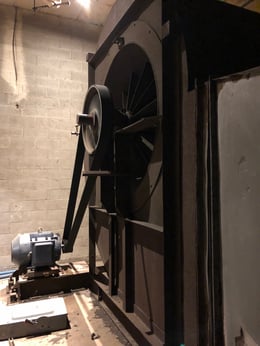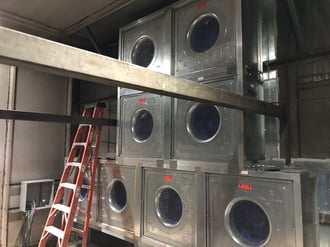Energy Efficiency | January 13, 2020
Sleeping with the Fan On: the Case for Fan Refurbishment
Sleeping with the fan on ensures the movement of air, in your bedroom and on your rooftops. But how do you know the fans in your air handling units (AHU) and rooftop units (RTU) won’t fail overnight? If equipment starts to fail or you’re spending a significant amount of the budget on the energy required to run those fans, now’s the time to look at a fan retrofit (also known as a rehabilitation or “rehab”, or a refurbishment or “refurb”). Let’s start with an example.
Instead of replacing your entire air handler to “keep the fan on,” you can simply make changes to the fan systems in it either just for operational improvements or additional efficiencies which can qualify for utility incentives. What’s that? You’ve been told to just get a whole new unit to the tune of thousands of dollars? Sure, while HVAC equipment does have a lifespan and eventually may need to be fully replaced, there are dozens of ways to retrofit existing equipment so you can: get more life out of existing systems, improve energy use and demand placed on that equipment, and save money overall.
Why retrofit equipment instead of replacing with something new?
Rehabilitating or refurbishing equipment with an ESCO (an Energy Services Company) is different from working with mechanical contractors who may often just replace old or broken equipment with a new or different model that essentially does the same thing.
The idea of a HVAC retrofit is to keep as much of the existing framework as possible and work within it to target inefficiencies or outdated functions, including parts of the AHUs, RTUs, boilers/chillers, wiring, piping and, of course, fans, among other components.
What will this “fan rehab” do for my AHUs/RTUs?
A fan rehab, available for many outdated AHUs and RTUs, is something many commercial/industrial facilities should consider. Instead of replacing the entire unit for an efficient model or ignoring the strain placed on equipment running at 100%, 24/7, this type of HVAC refurbishment can improve redundancy, airflow, efficiency and energy use.
Retrofitting fan motors means improving existing, less efficient equipment with efficient fans and updated controls, as well as programming, which will modulate airflow based on load, occupancy and predefined scheduling. It’s a simple thing to replace a piece of the equipment as opposed to changing the equipment itself.
What if I'm looking for dollars to pay for the refurbishment?
There’s something important to know. Yes, your utility may cut a hefty check to help pay for this project! But: there are 2 “if’s” to consider first:
- If you’re just changing fans one-for-one, or swapping a fan that already has a VFD to a fan with an internal VFD, this kind of upgrade might not always qualify for utility incentive dollars, which means if you’re not changing the specs of air output, you won’t necessarily be upgrading the efficiency of the equipment
- If specs change throughout the year for air handlers, that’s when we can typically obtain incentive dollars by fixing airflow. This means if the space your air handler is serving has changed (from office space to ORs or from a manufacturing floor to a clean room), the load of the air handler is different and there is typically room for efficiencies by redesigning the fan output.
Basically, if your retrofit project is changing the air load required and making the actual output more efficient, we can explore qualifying the project for free funding from the utility.
How might this air handler rehab work for my company?
Here’s an example of how this refurb works: Let’s say you have 1 fan carrying 100% of the performance and it dies. In place of changing out the entire unit for another fan, we can upgrade the equipment to have 5 fans managing 25% of the load each but only 4 are running at any given time (thanks to controls). Now, you get your 100% output needed, but there are 5 available, so if one fan craps out, you still have your full 100%.
Even if they don’t get an incentive for the project, fan arrays and fan refurbishments like this are a benefit because they provide added redundancy without an exorbitant amount of energy use.
This "before" and "after" shows the dramatic upgrade this client is seeing through a fan array retrofit that involved moving to 8+ fans:
|
BEFORE  |
AFTER  |
What are some examples of this upgrade in action?
For one major hospital, we’re retrofitting their large air handlers and replacing each fan section with fan arrays. This will allow them to have built in redundancy in the event of fan failure. The existing fans are centrifugal type sized for the full CFM and static pressure of the system. If the fan goes down, the air handler goes down. In the case of fan wall technology, the modular design of the fan wall allows built in redundancy to mitigate downtime and risk in the event of failure.
The application of the AHU changed, in this example, so this project qualified for utility incentives.
Alternatively, a pharmaceutical we’re working with wants to rehab fans on air handlers. These are critical to the pharma’s operations so they’re also considering a fan wall option. They don’t need to update the fans for efficiency, since the required output isn’t going to change. But, this company is interested in a fan refurb for the redundancy. They simply can’t afford for equipment failure. If one fan fails, the whole system is down. While this improves the redundancy of the fans, they aren’t changing the output so the project likely won’t qualify for utility incentives.
For a large number of facilities we work with, replacing AHUs is generally not an easy task. Most AHUs are older and located in basement mechanical rooms. Over time, mechanical rooms go through renovations and add equipment. The ability to rig out the existing AHU and rig in the new AHU becomes close to impossible. In many applications today, manufacturers will supply “knockdown” units that arrive at the site disassembled for the mechanical contractor to assemble in place. Though this is a nice solution when space is limited, it can be quite costly due to the intensive labor required for demolition and assembly. Whenever possible, explore a refurb first.
Any other benefits to retrofitting HVAC instead of replacing?
Actually, there may be. Depending on the work done, individual parts that are refurbished may not require the same kinds of permitting required for larger projects. This is evaluated on a case-by-case scenario of course, but it’s another reason to explore a retrofit instead of a replacement of your HVAC equipment.
Related Posts
Discover more content and insights from Mantis Innovation

The Cost of Inaction: Why Businesses Should Act Now on Energy Efficiency
In today's fast-paced business environment, the financial and operational losses businesses incur by delaying energy efficiency improvements, the "cost of inaction," is more relevant than ever.

In today’s AI era, human intelligence is the key to data center facility and energy optimization
Nowhere else in modern industry do artificial and human intelligence converge with such transformative potential as in the world of data centers. As AI's extraordinary growth accelerates demand for

Your Guide to LED Lighting for Business and Commercial Buildings
Never to be underestimated, LED lighting and well-designed lighting retrofits and upgrades offer businesses big improvements like reduced energy costs, reduced emissions, and improved working

Five Trends Driving Data Center Facility Energy Optimization
Today’s digital economy, commercial and industrial digitalization, and the recent explosion in artificial intelligence and machine learning (AI/ML) powered computing are driving massive growth in